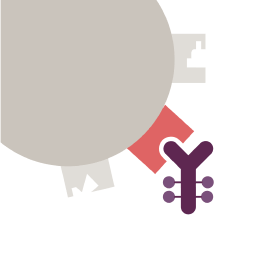Testing for FRα can be done as early as DIAGNOSIS TO UNDERSTAND HER TREATMENT OPTIONS AT PLATINUM RESISTANCE1,2
FRα=folate receptor alpha.
Why does FRα matter?
is a folate transport protein that is expressed in several types of cancer.3*
Up to 90% of patients
with ovarian cancer express FRα3,4

~35%
of patients
with advanced ovarian cancer have tumors that express FRα at a level that may make them candidates for ELAHERE monotherapy5,6
*Not to be confused with folate or folic acid.
Why is testing important?
ELAHERE is an ADC designed to target FRα in platinum-resistant ovarian cancer6
Knowing your patients' FRα status can help you be ready to treat with ELAHERE as soon as they become platinum resistant6,7
NCCN Clinical Practice Guidelines in Oncology (NCCN Guidelines®) for Ovarian Cancer Including Fallopian Tube Cancer and Primary Peritoneal Cancer recommend tumor molecular analysis, including FRα testing, for patients with recurrent disease to identify potential benefits from targeted therapies1
ADC=antibody-drug conjugate; NCCN=National Comprehensive Cancer Network® (NCCN®).
SPECIFICALLY REQUEST FRα TESTING FOR YOUR PATIENTS, AS IT MAY NOT BE AUTOMATIC7,8
Test for FRα with the FDA-approved VENTANA FOLR1 IHC assay7,9,10*
- Testing can be done as early as diagnosis
- FRα expression is identified via IHC, not with genomic testing, and it may need to be requested as an add-on (for example: in addition to a broad NGS panel)
Formalin-fixed, paraffin-embedded archival or recently acquired tissue can be used for the test
Act on the results for appropriate patients6,7
- Tumors with ≥75% of cells staining at ≥2+ intensity are considered FRα positive
- Patients who meet the above criteria and have platinum-resistant ovarian cancer may be candidates for ELAHERE
Test for FRα and see if your patients are eligible for treatment with ELAHERE as soon as they become platinum resistant6,10
*VENTANA FOLR1 (FOLR1-2.1) RxDx Assay.
FOLR1=folate receptor 1; IHC=immunohistochemistry; NGS=next-generation sequencing.
ELAHERE IS DESIGNED TO TARGET FRα-EXPRESSING CELLS6
ELAHERE is an ADC that binds to cell surface receptor FRα6,11-14

ELAHERE binds to FRα on the cell surface with high affinity

Upon binding, ELAHERE is internalized by the cell and delivers a cytotoxic molecule

This prompts intracellular release of DM4, a cytotoxic microtubule inhibitor, resulting in cell cycle arrest and apoptotic cell death

DM4 diffuses across the cell membrane and kills neighboring cells (bystander killing)*
*Via cell cycle arrest and apoptotic cell death.
The MOA of ELAHERE may affect cancer cells as well as neighboring healthy cells.15
MOA=mechanism of action.
NCCN Guidelines for Ovarian Cancer Including Fallopian Tube Cancer and Primary Peritoneal Cancer V.3.2025 recommend mirvetuximab soravtansine-gynx (ELAHERE®) as a NCCN Category 1, Preferred option for recurrence therapy in patients with folate receptor-alpha positive (FRα-expressing tumors [≥75% of positive tumor cells]), platinum-resistant epithelial ovarian, fallopian tube, or primary peritoneal cancer1,6,7
Need more information
about FRα testing?
A representative can answer additional questionsyou may have about testing for FRα. REQUEST A REP
Take a look
at the data
Explore the results of ELAHERE vs standard chemotherapy. VIEW THE DATA